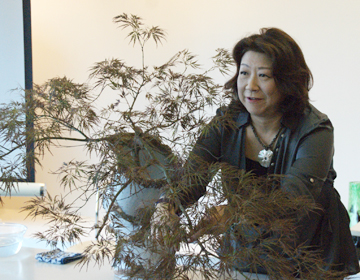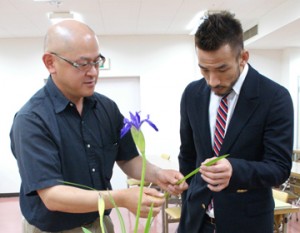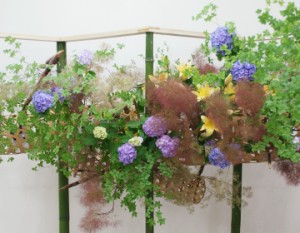Displaying for the mother-in-law?
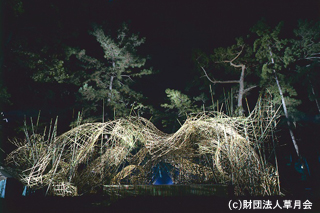
“When teaching at a college, I asked the students, “What kind of image do you have of ”ikebana”?” and a male student answered, “It’s something you would do sitting formally on a tatami mat in front of your mother-in-law.” I was shocked!” Akane Teshigawara, 4th Iemoto to Sogetsuryu Ikebana said with laughter.
Sogetsuryu Ikebana totally contradicts this image. Some of the pieces created by the Iemoto were huge, as big as a stage, using bamboo.
“This is considered ”ikebana” as well. My father was the first to adopt bamboo in his work, and the works tended to become very big. I myself made a stage using bamboo at the Imperial Villa in Numazu. It was gigantic. I braided vertically cut narrow bamboo and constructed the stage using a crane. Of course we have rules and the fundamentals, but more importantly, what exists inside the person arranging the flowers rules over that. I believe the fundamentals exist to help express that image,” Iemoto Teshigawara told us.
Transition of Ikebana
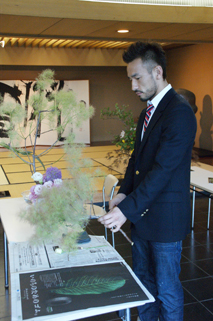
“The characteristic of Sogetsuryu is that it changes. Flowers change according to the arranger’s emotions. The creation is dependent on what it’s meant to express.” Teshigawara explained.
Nakata commented “I’m not sure how to appreciate ”ikebana”.”
This is up to the individual, Teshigawara explained, “For example, someone may create a dynamic work of art, hoping to express strength and energy. But some people may simply sympathize with the flowers being taken out of their natural environment. There is no correct answer to how you relate to the work. “
“But,” she added, “The creator must always add feeling and emotion. Unless their feelings are added, the value of the piece cannot be evaluated. The work would rely only on the beauty of the flowers themselves. To live up to a level of appraisal, you need to add a piece of “yourself” in it.”
Being Witness to the Birth of Art
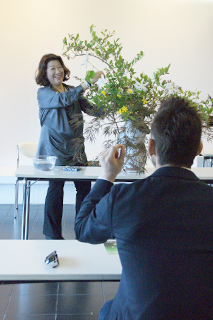
At the end, Teshigawara showed us an ”ikebana” demonstration. She made 2 pieces. The vase was one of her own creations. Her grandfather not only practiced ”ikebana”, but was also a calligrapher. Her father likewise practiced calligraphy, made his own ceramics, and was also a movie director.
As we watched, the vase and the plants take on a different form. Teshigawara not once stood with her back to Nakata. This form is called “ushiroike” meaning the work is created from behind the vase, showing every single transition of the creation. Her motions are at times swift, and other times very thought out.
Nakata asked after it is completed, “Do you have a final image in your mind before you start, or do you make it along the way?”
“I start with an image, but plants do not always comply. The exciting part about ”ikebana” is that you need to resonate with the plants. You have to communicate with the plants and sometimes, they may not be the exact shape or color you had imagined when you take them in your hand. You need to be flexible, which is the most exciting part about ”ikebana”.” There are no two plants exactly alike. Thus it is a collaboration between man and flower.



